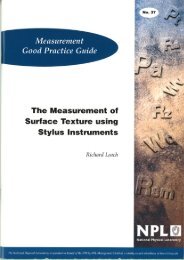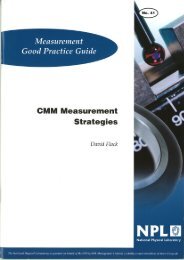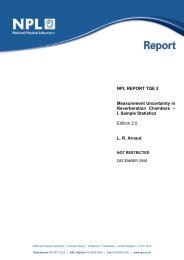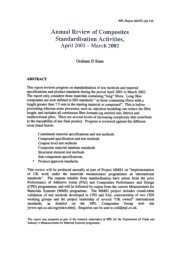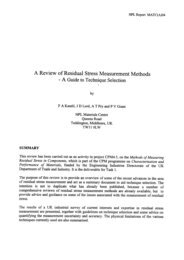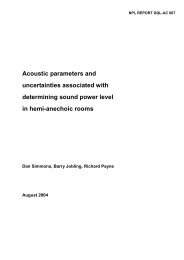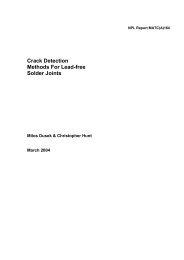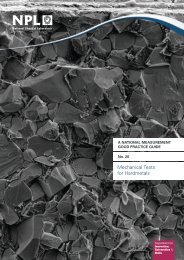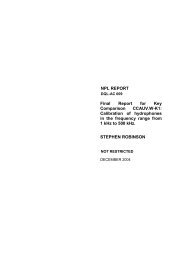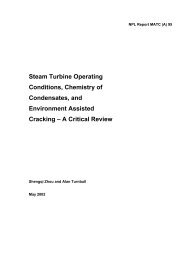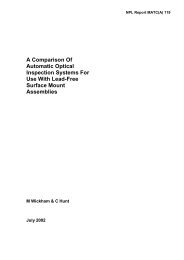Protocol for Establishing and Maintaining the Calibration - NPL ...
Protocol for Establishing and Maintaining the Calibration - NPL ...
Protocol for Establishing and Maintaining the Calibration - NPL ...
You also want an ePaper? Increase the reach of your titles
YUMPU automatically turns print PDFs into web optimized ePapers that Google loves.
8 Good Practice Guide 93 Chapter 1<br />
First, measure <strong>the</strong> activity of a solution in <strong>the</strong> st<strong>and</strong>ard container <strong>and</strong> <strong>the</strong>n transfer a known<br />
proportion of <strong>the</strong> liquid to <strong>the</strong> container <strong>for</strong> which <strong>the</strong> calibration is to be determined. The volume<br />
transferred may be determined by accurate weighing be<strong>for</strong>e <strong>and</strong> after transfer. To confirm <strong>the</strong><br />
activity removed, <strong>the</strong> original container can be re-assayed, having first adjusted <strong>the</strong> container to <strong>the</strong><br />
original volume using non-radioactive liquid of <strong>the</strong> same density. Having determined <strong>the</strong> activity<br />
transferred from <strong>the</strong> original container, <strong>the</strong> instrument setting required to display this activity <strong>for</strong> <strong>the</strong><br />
new container/volume can be determined by trial <strong>and</strong> error. During this procedure care must be<br />
taken to avoid loss of radioactive liquid during <strong>the</strong> transfer. This can be checked by monitoring all<br />
containers, syringes etc., involved in <strong>the</strong> process, <strong>and</strong> confirming that any residual activity is trivial.<br />
1.3.9 Linearity<br />
This should be measured over <strong>the</strong> entire range of activity <strong>for</strong> which a particular radionuclide<br />
calibrator will be used. The usual technique is <strong>the</strong> decaying source method. A vial containing <strong>the</strong><br />
maximum activity of a radionuclide used in <strong>the</strong> department is measured at intervals as <strong>the</strong> source<br />
decays. To cover <strong>the</strong> entire activity range this may require measurements to be made several times<br />
each day <strong>for</strong> several days. The activity at which non-linearities appear will be different <strong>for</strong> different<br />
radionuclides.<br />
Activity measurements can be recorded on a spreadsheet <strong>and</strong> a log-linear graph made of <strong>the</strong>se<br />
measurements plotted against time. With a linear system, this should be a straight line, <strong>and</strong> <strong>the</strong><br />
slope of <strong>the</strong> trend line produced <strong>for</strong> <strong>the</strong> whole of <strong>the</strong> data should equate to <strong>the</strong> decay constant of <strong>the</strong><br />
radionuclide used. Any difference will indicate that non-linearities exist.<br />
In order to quantify this non-linearity a region of <strong>the</strong> plot should be identified where <strong>the</strong> slope<br />
equates to <strong>the</strong> decay constant of <strong>the</strong> radionuclide used. Typically, this section of data is where <strong>the</strong><br />
measured activity is 100 times background <strong>and</strong> covers about 10 half-lives. This can <strong>the</strong>n be<br />
extrapolated back to obtain predicted activities at all measurement times. The activities at which<br />
<strong>the</strong> predicted activity <strong>and</strong> <strong>the</strong> measured activity differ by 1% (reference instrument limit) <strong>and</strong> 5%<br />
(field instrument limit) can <strong>the</strong>n be identified. For each radionuclide, <strong>the</strong> range of activities over<br />
which <strong>the</strong> instrument may be used as ei<strong>the</strong>r a field or reference instrument can <strong>the</strong>n be determined.<br />
A full outline of <strong>the</strong> method using 99m Tc, which is <strong>the</strong> most widely used radionuclide, is shown<br />
below.



